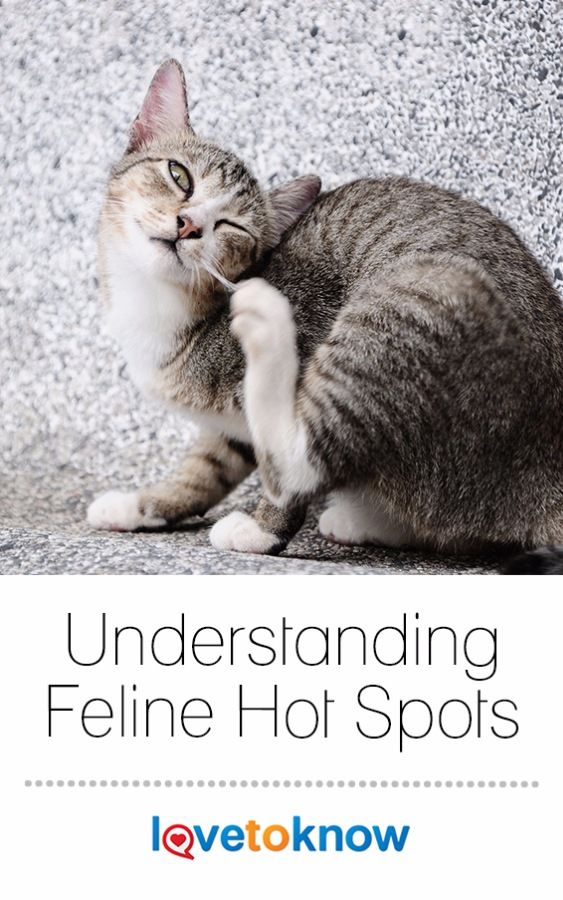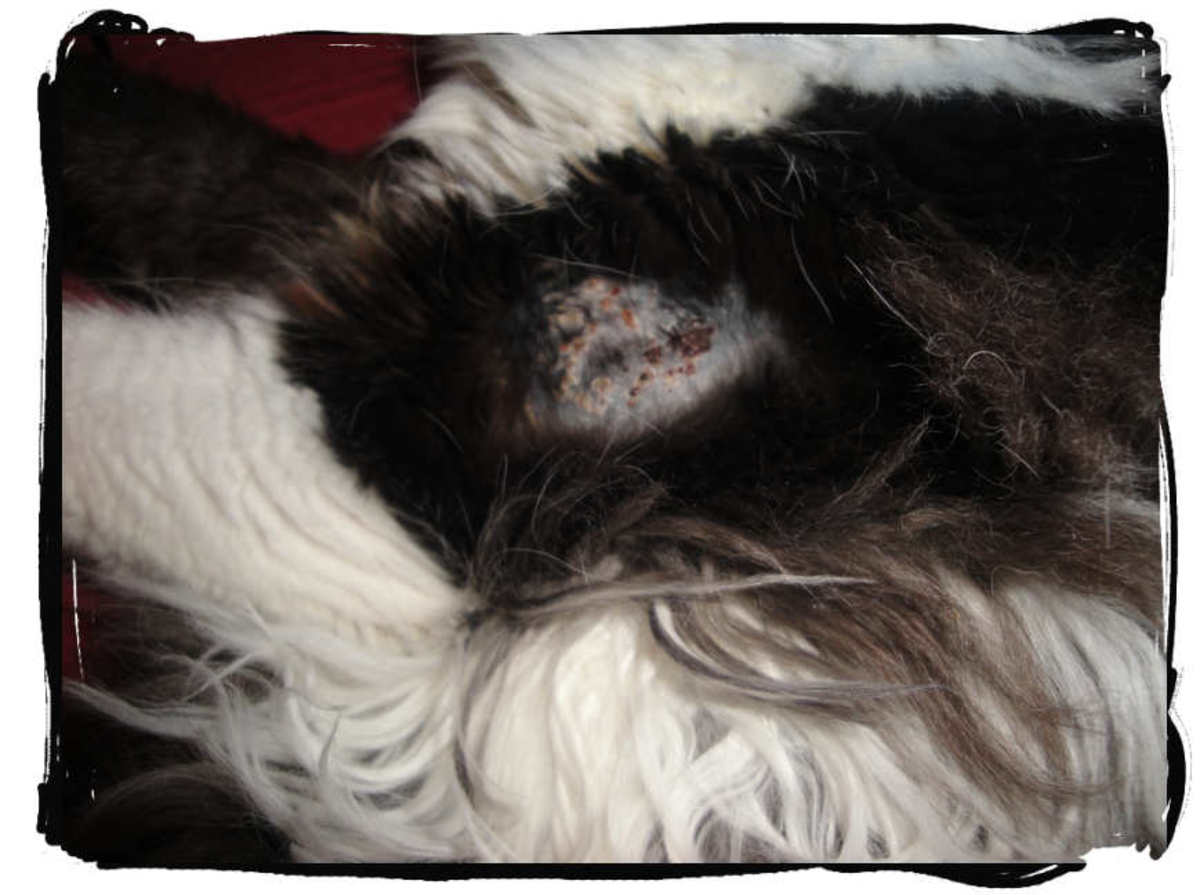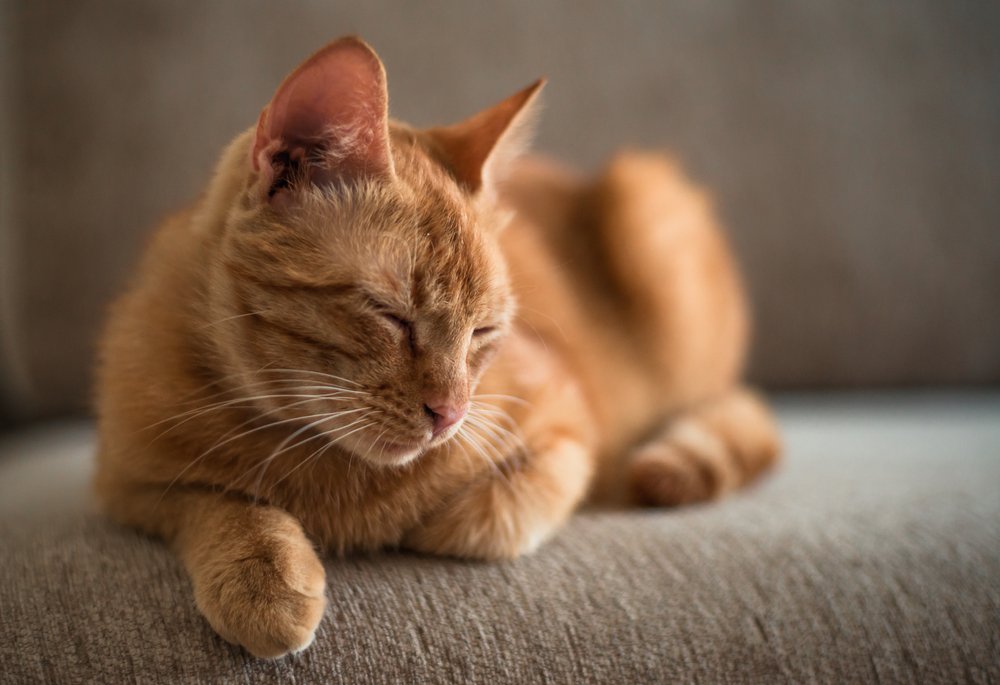Cleaning The Cat’s Hot Spot Wound
To speed healing, your veterinarian will need to clip the fur around the hot spots. The vet uses clippers or curved scissors to trim hair from around the area to improve access to clean the hot spot and allow for better air circulation. Topical ointments and oral antibiotics may both be used to heal the wound. These commonly contain a combination of antibiotics and anti-inflammatories . Most uncomplicated hot spots settle down with seven to fourteen days of treatment.
In extreme cases, the cat may need to wear an Elizabethan collar to prevent ongoing self-trauma to the hot spot. However, this is often distressing to the cat so the vet may give a low dose of a short-acting steroid in order to remove the tingle from the skin so the cat is more likely to leave it alone. In addition, if the infection has reached deeper layers of the skin, your cat may need oral antibiotics instead of a topical ointment.
Allergies And Feline Hot Spots
An allergic reaction occurs when the immune system perceives an otherwise harmless substance as a threat, thereby leading to a host of symptoms such as itchy skin, increased scratching, itchy eyes, runny eyes, itchy ears, paw chewing, sneezing, wheezing, diarrhea, vomiting, etc. The allergen could be airborne. It might be present in food or applied to the skin. An allergic reaction could also be triggered by flea bites.
An allergy could be triggered by tree pollen, grass pollen, weed pollens, dust mites, mold, cleaning products, perfumes, rubber, fabrics, drugs, fleas, etc. In case of contact dermatitis, skin irritation and itching is experienced only at the areas that come in contact with the allergen. Flea bites can also cause itching in cats. While feeding, fleas inject saliva into the cats skin. Their saliva contains proteins that can trigger an allergic reaction. In such cases, the cat is likely to scratch vigorously, thereby leading to the development of open sores and bald patches on the affected area. Fleas can also transmit other parasites such as tapeworms.
What Is Arthritis In Cats
Arthritis in cats is a condition characterized by joint inflammation. Also known as feline arthritis or osteoarthritis, its main sign ispainful joints. Arthritis is a chronic condition with limited treatment options.
As a type of degenerative joint disease, arthritis in cats is quite common. Statistics show that more than ninety percent of felines over twelve years of age show signs of arthritis.
Plus, arthritis in cats usually affects more than one joint. Forty-eight percent of arthritic cats have signs of joint damage in more than one joint.
Don’t Miss: Kittens For Adoption San Antonio
Signs & Symptoms Of Canine Hot Spots
Signs of hot spots on dogs may include redness, swelling, and hair loss. The hot spots are typically moist and may discharge pus or fluids that can dry to create crusting and matting of hair. Generally, hot spots are found on the hips, limbs, and head but they can occur anywhere on a dogs body. Due to bacteria that builds up in the hot spots, they can quickly spread to other parts of the dogs body. These affected areas will be painful and result in your dog itching and licking the area. Many of these symptoms overlap with other skin conditions so its important you contact your veterinarian right away.
Cons Of The Soft Cone

Although I do really like this pet collar, it doesn’t wear well after a lot of scratching from a cat. My kitty kept scratching her ears and scratching the cone. The drawstring started shredding, and so did the collar. It still works, but it will probably need to be replaced after my kitty wears it for a month. Still, to me, it’s worth it, because it’s comfortable for my cat.
Recommended Reading: What Are The Signs Of A Cat Dying
Breed & Health Resources
Copyright 2005â2022 Pet health insurance is administered by Embrace Pet Insurance Agency, LLC and underwritten by one of the licensed insurers of American Modern Insurance Group, Inc., including American Modern Home Insurance Company d/b/a in CA as American Modern Insurance Company , and American Southern Home Insurance Company. Coverage is subject to policy terms, conditions, limitations, exclusions, underwriting review, and approval, and may not be available for all risks or in all states. Rates and discounts vary, are determined by many factors, and are subject to change. Wellness Rewards is offered as a supplementary, non-insurance benefit administered by Embrace Pet Insurance Agency in the United States. © 2022 American Modern Insurance Group, Inc.
Other Skin Conditions To Look Out For
Skin or ear infections can be involved in the formation of hot spots.
- Yeast is present in your cats ears, but an overgrowth of this yeast will lead to inflammation and itching.
- Ringworm is often mistaken to be a parasite, but in fact, is a fungus that can grow on your cats skin. It can spread rapidly and make your cat extremely pruritic .
- Bacterial Infections are often opportunistic. They grow on the skin surface and sometimes deep in the skin once the immune system is weakened or your cat breaks the skin surface from scratching.
Also Check: Purina One Wet Cat Food
What Are The Signs Of Arthritis In A Cat
The most common symptom of arthritis in cats is pain followed by movement disorders. Let us take a look at some of the signs of osteoarthritis:
- Sluggish Movement. It is defined as additional effort or hesitance in jumping or standing.
- Limping. As the pain spikes, it is difficult to put pressure on the joint hence the lameness.
- Lethargy. The cat prefers to rest over walk and play to avoid the pain.
- Muscle Mass Loss. Muscles grow if used, and a sleepy cat will lose some of its muscle mass.
- Neglectful Grooming. Pain makes the cat disinterested or unable to groom itself.
- Altered Behavior. Behavior changes include unusual irritability or aggression.
- Litterbox Issues. Accidents outside the litter box due to discomfort when entering the box.
Finally You Need To Wait
For the next few weeks, continue your treatment regimen, preventing your cat from re-traumatizing the wound. During this period, watch the size of the hot spot and compare it to the marks you created at the outset of treatment. If the hot spot grows, something isnt working. It might be time to bring your cat to the veterinarian.
Also Check: Best Wet Cat Food For Feral Cats
How To Handle Hot Spots Or Summer Sores On Your Dog Or Cat
If your dog or cat has ever itched, licked, or scratched at a certain spot on his skin so much that it becomes inflamed and possibly infected, youand unfortunately your pethave experienced a hot spot. The broad definition of a hot spot is a sore on the skin that is so itchy your pet cannot leave it alone. The affected area is usually hot to the touch from the localized inflammation and skin infection, thus the name hot spot.
Although hot spots occur on both dogs and cats anytime of the year, some veterinarians also call them summer sores because the hot season brings about extra irritants that can cause the irritations to flare. Our regions summer warmth and humidity, coupled with any small cut, scrape, or irritation on your pets skin stimulates bacterial growth that can cause a hot spot.
A variety of factors such as allergies, insect bites, splinters, a new shampoo, or anything that causes an initial itch on the skin can be the culprit behind a hot spot. Flea allergy dermatitis is one common cause of hot spots for both cats and dogs, and for sensitive pets just one flea bite can cause a raging hot spot.
PetWellClinic® has three locations: 10549 Kingston Pike, Knoxville, TN 37922 7329 Kingston Pike, Knoxville, TN 37919 and 228 S. Calderwood Street, Alcoa, TN 37701. Learn more about how PetWellClinic® can exceed your expectations for affordable, top quality pet care by visiting our website at www.petwellclinic.com.
Tags:
Are Hot Spots Really Caused By Age Dysplasia And Arthritis
Hot spots may indeed come about as an indirect result of old age, arthritis, and hip dysplasia. When a cat feels pain or discomfort, it is likely to lick at the affected area in an effort to alleviate that pain.
Excessive licking and scratching will lead to hair loss and eventually breaking of the skin, which is the key factor in creating an infected hot spot.
If the cause of the issue is indeed internal or age-related, the vets best bet is to prescribe pain medication that will need to be managed. In most cases, this will suffice.
There are other measures you may need to take, like making your cats favorite areas easier to access or providing a comfortable, warmer place to relax if your winters are cold.
You May Like: Why Is My Cat’s Fur Greasy
Final Thoughts On Cats And Hot Spots
So, in answer to the original question: yes, cats can get hot spots. It seems a common enough occurrence in domestic pets like cats and dogs. Fortunately, a well-recognized regimen of treatment exists for the condition.
Moreover, hot spots may not be immediately serious as a medical condition. Nonetheless, it is irritating and can lead to complications if the wound becomes seriously infected.
If you suspect your cat has a hotspot, seek a vets advice immediately, and make a point of isolating the possible or probable cause. That way, you can fix the problem once and for all.
This do cats get hotspots post contains affiliate links. That means if you click through and make a purchase I will most likely receive a small commission. This wont affect the price you pay. Just wanted to make sure you knew.
How I Resolved My Cat’s Hot Spots

My cat’s hot spots seemed to be getting worse for a timegrowing bigger and not healing. I noticed she was licking these spots quite frequently. So, I got a cone and put it on her. At first I tried a padded kind, the Comfy Cone Pet E-Collar, but it didn’t look very comfortable. I already had the hard plastic kind from a previous vet visit, but those weren’t my favorite either.
Don’t Miss: How Many Vertebrae Do Cats Have
What Causes A Hot Spot
Parasites, allergies, infections, warm weather and anything that makes your cat itchy can cause a hot spot. In general, I see hot spots more in the spring, summer and fall. This is also bug and allergy season, when the weather is warm and humid.
- Parasites: In my experience, fleas are the most common cause of hot spots in cats, but other parasitessuch as mites , mosquitoes, flies and even ant bitescan cause the initial irritation that starts a hot spot.
- Allergies: After parasites, allergies are the second most common cause of hot spots. Cats can have seasonal allergies to pollen, grass, trees, weeds, fungus and dust mites. Cat food allergies and allergies to fleabites can also cause hot spots. Cats have a different reaction to allergens than people. People typically develop a runny nose, runny eyes and a lot of sneezing. Cats usually develop itchiness to the skin. Some cats are actually allergic to flea saliva, so just a few fleabites can cause them to be extremely itchy.
- Infections And Pain: Another possible source of hot spots is ear infections. The ear infection is itchy, so your cat scratches at the ears and some of the skin below the ear. The self-trauma from scratching can lead to a hot spot just below the ear. Ringworm infections are sometimes itchy enough to cause a hot spot to develop. A few hot spots are related to painful conditions like hip arthritis. This could cause your cat to lick and chew at the skin above the hips, causing a hot spot to form on that area.
Do Homeopathic Or Natural Treatments Work
Its difficult to vouch for whether natural treatments or homeopathic approaches work for hotspots. What can be taken into account is that there are very specific medical explanations for hotspots, so scientific medical treatment is likely to work best.
That said, it is possible that some home remedies can alleviate some of the symptoms, though to what degree, is uncertain.
Read Also: Best Cat Litter For Dust Control
What Causes Hot Spots On Dogs
Certain breeds are predisposed to skin conditions, including hot spots. Commonly affected breeds include Golden Retrievers, English Bulldogs, and German Shepherds.
Most hot spots on dogs are caused by an underlying condition that either causes itchiness, excessive licking, or excessive moisture.
The most common conditions include:
You should also seek veterinary attention sooner if you cannot keep your pet from licking/scratching it.
Hot Spots And Your Pet
The team members at Naperville Animal Hospital are no strangers to itchy dogs. From ear infections to seasonal skin allergies to fleas, we see it all. Hot spots are one common reason that pets land on our appointment schedule and they are something we think all pet owners should know a little about.
You May Like: What To Give Cat For Uti
Management For Cat Arthritis
Cat management is an essential part of feline arthritis treatment. It includes three different aspects a healthy diet, proper exercise, and weight control. Lets review each approach:
- Healthy Diet. It is important to feed your cat high-quality food that supports healthy joints, reduces inflammation, and supports optimal weight.
- Proper Exercise. You need to keep the arthritic cat active. The activity should be in accordance with the cats mobility. Talk to your vet about the best exercises.
- Weight Control. Obese cats with arthritis need to be put on a weight loss regimen. The extra weight adds pressure to the cats joints and worsens the situation.
Are Hot Spots Likely To Recur
Unfortunately, dogs that get hot spots are prone to getting them again. Taking preventive measures such as proper grooming and bathing as well as flea control can help reduce the risk of hot spots recurring on dogs. If your dog experiences chronic hot spots, we suggest talking with your veterinarian about getting your dog tested for hypothyroidism, skin and food allergies, and joint problems.
Don’t Miss: Using Pellets For Cat Litter
What Are Hot Spots On Dogs
Hot spots, also known as acute moist dermatitis, are painful, red areas of infected skin that appear to be irritated and are sometimes raised.
Hot spots on dogs can occur anywhere on the body, but they are commonly found on the face, neck, limbs or hips. The size and appearance of the lesions can vary slightly in each location, but most will look similar regardless of where they are.
These spots can appear quickly, usually with some degree of hair loss, and they become much larger in a matter of days.
Hot spots on dogs can be relatively minor and heal quickly, but they do have the potential to cause more serious issues, such as widespread infection or deeper skin ulcerations.
How To Treat A Hot Spot

When I treat a hot spot, it usually requires several steps.
In my experience fleas are the most common cause of hot spots. Thus, strict flea control for your cat is a must. Consult your veterinarian about the best flea control to use for your cat. In more severe flea infestations, spraying the yard and treating the house may also be necessary.
Read Also: Why Does My Cat Lick My Eye
Causes Of Hot Spots In Cats
The moist acute dermatitis is a self-inflicted condition: the cat scratches and bites a certain area of its skin until it becomes sore anditchy. The condition aggravates, as the cat scratches the sore spot more, which makes it itch more, so a vicious circle is created.
The primary causes which make the cat compulsively scratch a certain area vary a lot:
- Parasites such as fleas or mites
- Insect bites
- Allergy to something the cat has inhaled or swallowed
- Poor grooming
- Boredom or stress
You Can Help Your Pet
You will want to treat what may be causing your pet’s hot spot along with the hot spot itself. Consult your veterinarian to determine if your pet has food, contact, or airborne allergies. Guard against fleas and ticks by protecting them with a vet-quality flea and tick treatment from PetArmor®. In addition, keeping your pet properly groomed can go a long way toward preventing hot spots.
You May Like: How Do You Stop Cats From Peeing On The Carpet